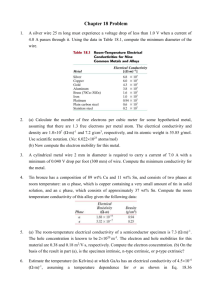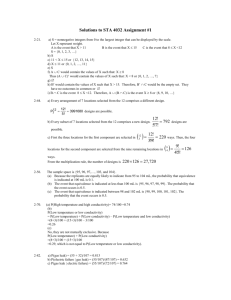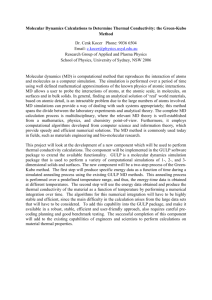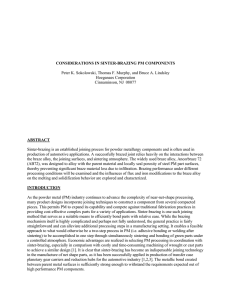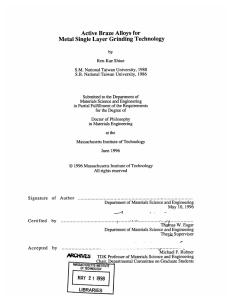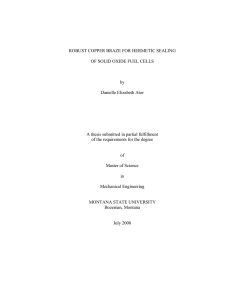Final Report on Eddy Current Analysis of the Dispersion
advertisement
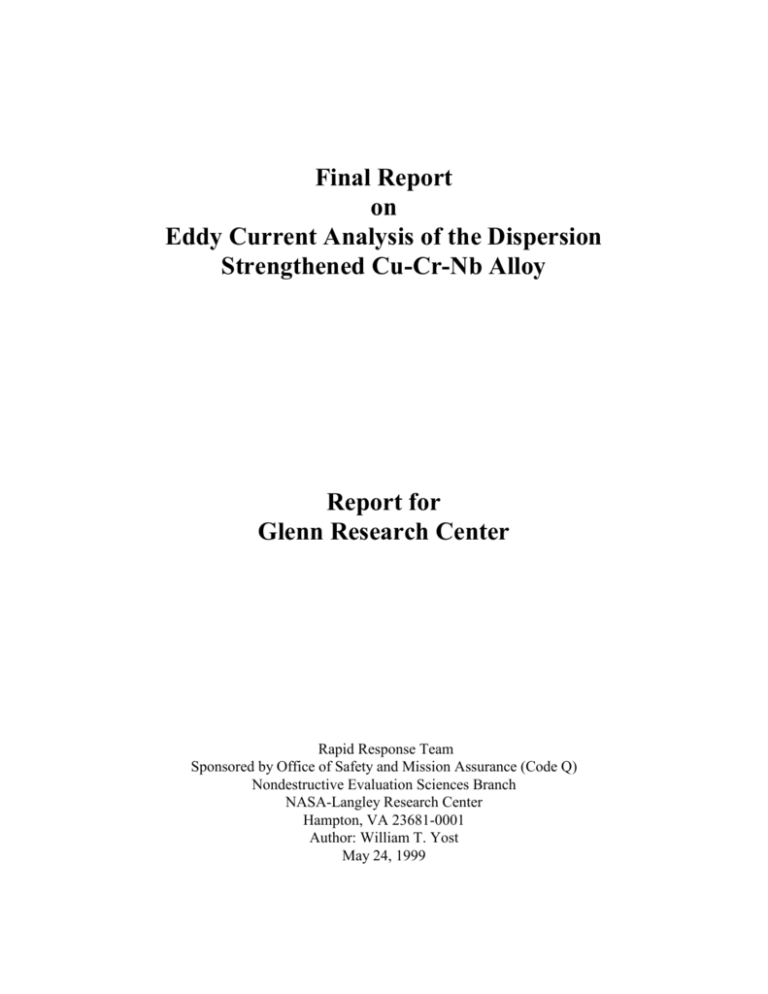
Final Report on Eddy Current Analysis of the Dispersion Strengthened Cu-Cr-Nb Alloy Report for Glenn Research Center Rapid Response Team Sponsored by Office of Safety and Mission Assurance (Code Q) Nondestructive Evaluation Sciences Branch NASA-Langley Research Center Hampton, VA 23681-0001 Author: William T. Yost May 24, 1999 On 1/9/99, and at the request of David Ellis of Glenn Research Center, we began an eddy current investigation to assist in the development of an NDE technique to determine the effects of certain heat treatments on a Cu-Cr-Nb alloy for combustion chambers for the RLV/Venture Star Program. We have tested a set of 8 samples that have been prepared and sent to us by Dave, and which we received on 2/17/99. On 2/19/99, we notified Dave of the preliminary results that our eddy current technique is of sufficient sensitivity to separate the heat treatments. Since that time, we have analyzed the data and include the results of the analysis in this report. Our effort has been funded by Code Q. Brief review of eddy currents In eddy-current analysis, material is exposed to a fluctuating magnetic field (FMF) . In response the material develops eddy currents which produce a counter magnetic field (CMF) to oppose the FMF. Therefore a sensor placed at the material’s surface records the vector sum of FMF and CMF. Since the material’s conductivity determines the size of CMF, the sensor’s response gives a measure of the material’s conductivity in the region of the sensor. The frequency of the fluctuations is chosen for penetration depth within the material. We selected frequencies that would penetrate on the order of millimeters into the Copper-Chromium-Niobium alloys, with the lower frequencies giving the greater penetration. The numbers that are given in this report are determined by a calibration technique that compares each measurement with measurements made on four calibrated conducting 2 materials whose respective conductivities are in the same range of the samples. A computerized measurement system is used for instrument calibration and for measurements. The instrument is calibrated at each frequency. The calibration is checked against standard samples and the instrument is determined to be within ±2% in the range of these measurements. This is determined to be of sufficient accuracy for this application. Figure 1 shows the circuit diagram of the instrument used for this investigation. Figure 2 shows a photograph of the measurement system. We use a partially shielded coil placed within the drive coil for this application. Such an arrangement concentrates the magnetic flux in a region between the drive coil and the pick-up coil which, from our experience, appears to provide more sensitivity to microstructure variables in copper-based alloys. The probe was developed as part of the LaRC “Self Nulling Probe” technology. Construction details of amplifiers, sensor, and sensor housing used in these measurements are shown in the appendix. 3 Figure 1. 4 Figure 2. 5 Electrical conductivity is useful for, among other things, the study of order-disorder changes in solid solutions. Electrons are incoherently scattered by randomly spaced solute atoms. For low concentrations in solid solution one expects that the concentration of solute atoms linearly affects the material’s resistivity. On the other hand, in a wellordered alloy the conductivity approaches that of a pure metal. Measurement Procedures We examined two different alloys that were solution-heat treated (Samples 1 and 4), then aged (Samples 2 and 5), and then subjected to a simulated braze cycle (Samples 3 and 6), as given in Tables 1 and 2 below. Another alloy (Cu-8a%Cr-4a%Nb) is extruded rod. This alloy (Sample 7) is then subjected to the simulated braze cycle (Sample 8). Frequencies chosen for operation are 15 Khz, 30 Khz, 45 Khz, and 60 Khz. in order that any frequency-dependent effects could be ascertained. Samples 7 and 8 are measured on ends and on curved surfaces. Techniques were developed to reduce variation caused by measurement on curved surfaces. In all cases 10 measurements are taken at random sites on all samples. A mean and a standard deviation is computed for each sample and for each frequency. In the material used for this investigation the ratio of chromium atoms to niobium atoms are always in the ratio of 2 to 1. We therefore plot all graphs involving solute concentration as simply the atomic percent concentration of chromium in the sample. 6 Summary of Samples Sent to the Rapid Response Team for Analysis Eight samples representing two different processing techniques, three heat treatment conditions and three different alloys were sent for analysis. Table 1 gives a summary of the samples. Sample # 1 Table 1 - Thermal History of the Cu-Cr-Nb Samples Alloy Heat Treatment General Comments Cu-1 at. % Cr-0.5 at.% Nb 2 Cu-1 at. % Cr-0.5 at.% Nb 3 Cu-1 at. % Cr-0.5 at.% Nb 4 Cu-2 at. % Cr-1 at.% Nb 5 Cu-2 at. % Cr-1 at.% Nb 6 Cu-2 at. % Cr-1 at.% Nb Solution Heat Treated 1000°C/1 h/WQ Solution Heat Treated 1000°C/1 h/WQ + Aged 500°C/1 h/AC Solution Heat Treated 1000°C/1 h/WQ + Aged 500°C/1 h/AC + Simulated Braze Cycle Solution Heat Treated 1000°C/1 h/WQ Solution Heat Treated 1000°C/1 h/WQ + Aged 500°C/1 h/AC Solution Heat Treated 1000°C/1 h/WQ + Aged 500°C/1 h/AC + Simulated Braze Lowest strength material of all samples Highest strength for this alloy Strength decreased from sample 2 but should be better than sample 1 Lowest strength for this alloy but better than sample 1 Highest strength for this alloy and better than sample 2 Strength decreased from sample 5 but should still be better than sample 4 and 3 7 7 8 Cu-8 at.% Cr-4 at.% Nb Cu-8 at.% Cr-4 at.% Nb Cycle As-Extruded Extruded + Simulated Brazed Cycle Highest strength material Approximately 3 ksi descrease in strength from sample 7 but still better than samples 1-6 The simulated braze cycle is a complex heat treatment meant to mimic the brazing of the rocket engine combustion liner to the support structure. The details are given in Table 2. Table 2 - Simulated Braze Cycle in Fahrenheit in Celsius RT to 1000°F @ 10°F/min RT to 538C@ 5.5C/min 1000 to 1600°F @ 5°F/min 538C to 871C @ 2.8C/min 1600 to 1715°F @ 3°F/min 871C to 935C @ 1.7C/min 1715°F ±15°F hold for 22.5 935C ± 8.3C hold for 22.5 min. min 1715 to 1600°F @ -3°F/min 935C to 871C @ -1.7C/min 1600 to 1000°F @ -5°F/min 871C to 538C @ -2.8C/min 1000 to RT free cool 538C to RT free cool Results Essentially no frequency dependence is found in (flat) samples 1 through 6. Samples 7 and 8 (extruded rod) show a frequency dependency in the curved surface measurements which disappear on measurements at the flat surfaces at the sample ends. Conductivity of the Cu-1a%Cr-0.5a%Nb are shown in Figure 3. Similarly, conductivity of Cu-2a%Cr1a%Nb are shown in Figure 4. In both of these bar graphs the conductivity is measured in IACS units versus frequency (Khz). Within each frequency, the treatments (the solution heat treatment-quench, the aging, and the simulated braze cycle) are sequentially displayed. Figure 5 is a bar graph of the conductivity of Cu-8a%Cr-4a%Nb (bar stock, 8 approximately 8.4mm diameter) when measured at the sample ends. Again the bar graph displays the conductivity against frequency. Within each frequency the as-received and the simulated braze cycle are shown. Figure 6 is a plot of the average value over the frequency computed for both the extruded (Sample 7, 8.500mm diameter) and the extruded-simulated braze cycle (Sample 8, 8.361 mm diameter). For completeness measurements are also taken on the curved surfaces of the bar stock (Figure 7). These show a strong frequency dependency which most likely is caused by surface curvature, since a similar frequency dependency is also observed in a solid copper rod of 8.395 mm diameter (Figure 8). The curved line shows measurements vs. frequency on the 9 cylindrical surface. The straight line shows measurements vs. frequency at cylinder ends. Figure 3. 10 Figure 4. 11 Figure 5. 12 Figure 6. 13 Figure 7. 14 Figure 8. Microstructure Implications from the Measurements. Because of the careful control of the variables in the heat treatment of these samples that were provided for this study, we are able to compare the results with predictions about the conductivity (and resistivity) of metals with low atomic percent of solute atoms. We perform this analysis when possible to add knowledge of the implications of the NDE measurements that are taken. If the sample were pure copper, the conductivity would be slightly more than 100 IACS units. When the atoms of the solutes are randomly added, 15 they act as scattering sites for the conduction electrons during movement through the CuCr-Nb solution. Whenever a conduction electron is scattered, the material’s resistivity rises which gives a consequent drop in the material’s conductivity that the instrument measures. A direct verification of the theory and measurement of the scattering potential of the Cr2Nb precipitate would require more data from samples (in the range of Cu-3a% Cr-1.5a%Nb to Cu-7a%Cr-3.5a%Nb). However, the available data is consistent with the theory of conductivity of dilute solid solutions. Solution Heat Treatment Conductivity of solution heat treated and quenched samples 1 and 4 (Figures 3 and 4) showed substantial variation in conductivity with concentration of solute atoms. Further analysis showed that the resistivity of the samples follows the linear prediction of the theory of electron scattering from randomly spaced scatterers within the lattice as shown in Figure 9. This implies high disorder of chromium and niobium atoms within the copper lattice, with the consequent electron scattering by randomly-spaced chromium atoms and niobium atoms throughout the lattice. On the basis of this theory one expects a conductivity of the Cu-8a%Cr-4a%Nb in the range of 12-16 IACS units if the material are subjected to the same solution heat treatment and water quenching used with samples 1 and 4. 16 Aging Treatment Only a slight dependence on the concentration of solute atoms is shown in the measurements. The conductivities of the samples 2 and 5 (Figures 3 and 4) are within a standard deviation. This is consistent with the fact that as the precipitate forms and grows with aging, there is an increased order within the alloy. The precipitate (Cr2Nb) is a complex FCC heavily faulted structure which also affects the conductivity. The conductivity is relatively independent of precipitate concentration increases brought about 17 by aging, which is also consistent with the theory of conduction in alloys The effect of change in solute concentration is much smaller on resistivity in aged material than in solution heat treated & quenched material as shown in Figure 9. Hence the conductivity of aged material is higher than for solution heat-treated & quenched material, but less than that of pure copper. The extrapolated value for resistivity does not approach that of pure copper. This may indicate electron scattering from the precipitate. We make the conjecture that the y-intercept is indicative of the electron scattering matrix of the (Cr2Nb) precipitate, but more samples and data would be needed to make any stronger statement. Simulated Braze Cycle In all cases the simulated braze cycle lowered the conductivity of the alloy. Possibly some of the precipitates wholly or partially dissolve with a consequent diffusion to nearby locations during the cycle’s time-temperature processing. These added, somewhat randomly located, scattering sites would increase the scattering of the conduction electrons in the material which increases the resistivity, resulting in a lower conductivity. Since the maximum temperature of brazing is near the solution heat treatment temperature (within 65C), one expects a partial dissolution of the precipitate. Conclusions 18 These measurements are made with an eddy-current instrument designed for this specific application. Central to this instrument is a focused magnetic field-based probe that interrogates smaller volumes of material, which is useful to determine the uniformity of the alloy. The instrument as configured for these measurements has sufficient sensitivity to detect those heat affected areas in the alloy that result from brazing, provided that a congruence exists between the simulated braze cycle and the actual brazing process. The measurement uncertainty due to point-to-point measurement variations in the heat treated material is low (approximately ±2% of measurement for standard deviation) If the finished product fabricated from this alloy maintains the high uniformity of heat treatment as were in the samples, then this technique can be used to verify the extent of the zone affected by the brazing operation. However, caution must be exercised if measurement is made on a surface with a short radius of curvature. 19


